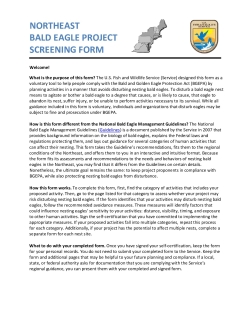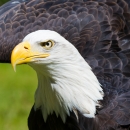
What is the purpose of this form?
The U.S. Fish and Wildlife Service (Service) designed this form as a voluntary tool to help people comply with the Bald and Golden Eagle Protection Act (BGEPA) by planning activities in a manner that avoids disturbing nesting bald eagles. To disturb a bald eagle nest means to agitate or bother a bald eagle to a degree that causes, or is likely to cause, that eagle to abandon its nest, suffer injury, or be unable to perform activities necessary to its survival. While all guidance included in this form is voluntary, individuals and organizations that disturb eagles may be subject to fine and prosecution under BGEPA.
How is this form different from the National Bald Eagle Management Guidelines?
The National Bald Eagle Management Guidelines (Guidelines) is a document published by the Service in 2007 that provides background information on the biology of bald eagles, explains the Federal laws and regulations protecting them, and lays out guidance for several categories of human activities that can affect their nesting. This form takes the Guideline’s recommendations, fits them to the regional conditions of the Northeast, and offers them to you in an interactive and intuitive format. Because the form fits its assessments and recommendations to the needs and behaviors of nesting bald eagles in the Northeast, you may find that it differs from the Guidelines on certain details. Nonetheless, the ultimate goal remains the same: to keep project proponents in compliance with BGEPA, while also protecting nesting bald eagles from disturbance.
How this form works.
To complete this form, first, find the category of activities that includes your proposed activity. Then, go to the page listed for that category to assess whether your project may risk disturbing nesting bald eagles. If the form identifies that your activities may disturb nesting bald eagles, follow the recommended avoidance measures. These measures will identify factors that could influence nesting eagles’ sensitivity to your activities: distance, visibility, timing, and exposure to other human activities. Sign the self-certification that you have committed to implementing the appropriate measures. If your proposed activities fall into multiple categories, repeat this process for each category. Additionally, if your project has the potential to affect multiple nests, complete a separate form for each nest site.
What to do with your completed form.
Once you have signed your self-certification, keep the form for your personal records. You do not need to submit your completed form to the Service. Keep the form and additional pages that may be helpful to your future planning and compliance. If a local, state, or federal authority asks for documentation that you are complying with the
| Attachment | Size |
|---|---|
| northeast-bald-eagle-project-screening-form-2021-12-01.pdf3.52 MB | 3.52 MB |
